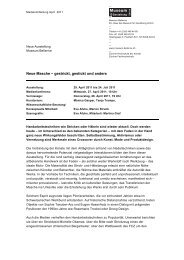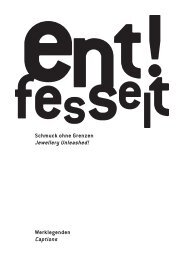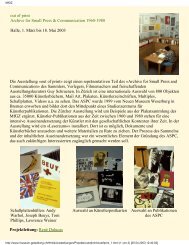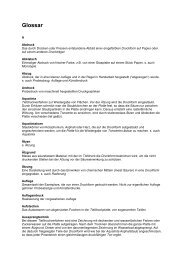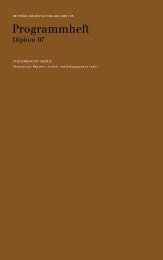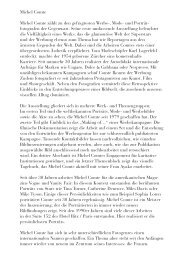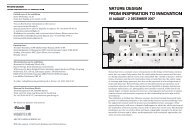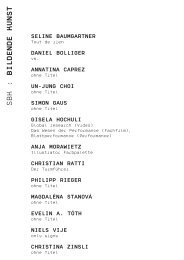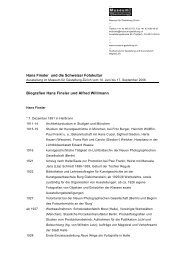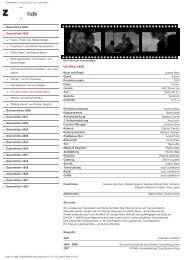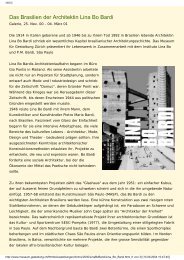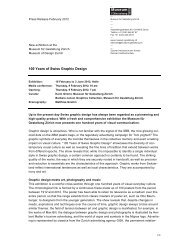Formless Furniture - eMuseum
Formless Furniture - eMuseum
Formless Furniture - eMuseum
You also want an ePaper? Increase the reach of your titles
YUMPU automatically turns print PDFs into web optimized ePapers that Google loves.
<strong>Formless</strong> <strong>Furniture</strong><br />
Museum für Gestaltung Zürich<br />
11 November 2009 – 14 February 2010<br />
Sacco, 1968<br />
Design: Gatti, Paolini, Teodoro<br />
Manufacturer: Zanotta<br />
Vinyl-coated textile, styrofoam pellets<br />
© MAK/Georg Mayer<br />
Terrazza DS 1025, 1973<br />
Design: Ubald Klug, De Sede AG<br />
Manufacturer: De Sede AG<br />
Polster auf Holzsockel. Bezug Leder<br />
© Museum für Gestaltung Zürich, Designsammlung/ Foto: Franz Xaver Jaggy<br />
Armchair (Portrait of my Mother’s Chesterfield Chair), 1964<br />
Design: Gunnar Aagaard Andersen<br />
Manufacturer: Dansk Polyether Industri<br />
Polyurethane foam<br />
© Tecta/MAK<br />
Sofa LOGO, 1994, Unique piece<br />
Designed and produced by Bär +Knell<br />
Base made of used plastic packagings, dyed black<br />
Upper side made of used shopping bags and packagings showing brand logos<br />
© MAK/Georg Mayer<br />
PUBLICATION<br />
<strong>Formless</strong> <strong>Furniture</strong>, edited by Peter Noever, concept and text by<br />
Sebastian Hackenschmidt and Dietmar Rübel, German/English, MAK,<br />
Vienna /Hatje Cantz, Ostfildern 2008, CHF 42<br />
GUIDED TOURS (in German)<br />
Every Tuesday, 6.30pm<br />
Every first Sunday monthly 3pm<br />
New as of 1 January 2010:<br />
Wednesday, 6pm: 6.1./13.1./20.1./27.1./3.2./10.2.<br />
Sunday, 11am: 10.1./17.1./24.1./31.1./7.2.<br />
Information for guided tours (also in English), workshops and events<br />
on: www.museum-gestaltung.ch<br />
EXHIBITION TALKS (in German)<br />
Dienstag, 17. November 2009, 18.30 Uhr<br />
Zeitlos formlos<br />
Mit Prof. Dr. Jacqueline Otten, Direktorin Departement Design ZHdK<br />
und Cynthia Gavranic<br />
Dienstag, 8. Dezember 2009, 18.30 Uhr<br />
Formlose Körperhaltungen<br />
Mit Esther Sutter Straub, Publizistin im Bereich Tanz, Pädagogin für<br />
zeitgenössischen Tanz und Tai Ji, Basel und Cynthia Gavranic<br />
Mittwoch, 6. Januar 2009, 18 Uhr<br />
Formlos schön?<br />
Mit Jörg Boner, Designer Zürich und Cynthia Gavranic<br />
Mittwoch, 27. Januar 2010, 18 Uhr<br />
Gegen die „Gute Form“<br />
Mit Arthur Rüegg, Architekt Zürich und Cynthia Gavranic<br />
OPENING TIMES 2009<br />
Tuesday–Thursday 10am–8pm, Friday–Sunday 10am–5pm<br />
Closed on Mondays as well as on 25.12. and 1.1.<br />
New as of 1 January 2010:<br />
Tuesday–Thursday 10am–5pm, Wednesday 10am–8pm<br />
IMPRINT<br />
Exhibition concept: Sebastian Hackenschmidt, MAK, Vienna and<br />
Dietmar Rübel<br />
Curator and project management: Cynthia Gavranic<br />
Scientific collaboration: Gabriella Disler, Nathalie Killias<br />
Coordination: Christine Kessler<br />
Exhibition design: Françoise Krattinger<br />
Construction: Jürg Abegg / Andrea Castiglia, Nils Howald, Frank<br />
Landes, Mohsen Rahimi, Domenico Scrugli, Mark Weibel<br />
Graphic design: Moritz Wolf<br />
Communication: Bernadette Mock<br />
Publishing: Christina Reble / Annamaria Keel<br />
Museum services: Mireille Osmieri / Reto Blaschitz<br />
Head of exhibitions: Angeli Sachs<br />
Photography: ZHdK Fotoatelier<br />
Translations: Steven Gander, Wien<br />
Print media: Hi – Visuelle Gestaltung, Claudio Barandun / Megi<br />
Zumsteig, Luzern<br />
Workshops: Elfi Anderegg, Zürich<br />
The educational programme of the Museum für Gestaltung Zürich<br />
and the Museum Bellerive is supported by the CREDIT SUISSE<br />
FOUNDATION<br />
An exhibition by the MAK, Vienna<br />
Museum für Gestaltung Zürich<br />
Christian Brändle, Director<br />
Zürcher Hochschule der Künste, Zürcher Fachhochschule<br />
FORMLESS FURNITURE—can there be such a thing?<br />
Isn’t it so that all material things and objects have a<br />
form, whether it is solidly outlined or fluid and transient?<br />
Don’t everyday utility objects have a predefined form<br />
which derives from, and at the same time expresses,<br />
its function? And isn’t it so that, particularly, furniture<br />
has taken various different forms over the centuries,<br />
which made it appear as typical of a certain style or<br />
taste, a specific epoch, school, tradition, fashion, region,<br />
or nation? Ever since the 1960s, designers have<br />
kept trying, with material experiments and alternative<br />
design approaches, to develop counter-proposals to<br />
existing designs and to create formless objects whose<br />
complex arrangements and formations still remain to<br />
be explored. In their chaotic structures, the un-forms<br />
of felt strips, heaps of rags, wire mesh, poured plastic<br />
and foamed-up piles often go even beyond overladen<br />
Baroque forms, signaling a radical breach with the geometrical<br />
vocabulary of classical and modernist design.<br />
And the anti-aesthetic category of formlessness still<br />
serves well to playfully undermine common notions of<br />
“good form”: formless furniture is not least to be understood<br />
as a deliberate offense against good taste, or<br />
as a rejection of conventional tenets in interior design.<br />
A central role in this is played by materials: formless<br />
furniture is the result of certain material qualities rather<br />
than design. Many of the objects exhibited have no<br />
definite form, but are changeable in appearance due<br />
to their softness and flexibility. What has always gone<br />
together with furniture-like anti-forms is the hope of<br />
countering the standardized uniformity of objects and<br />
everyday life with alternative designs for living: formless<br />
furniture is meant to provoke critical intervention and<br />
irritations that could probably lead to new ways of life<br />
and behavior. The exhibition <strong>Formless</strong> <strong>Furniture</strong> for the<br />
first time brings together various different aspects and<br />
manifestations of the formless in furniture design, focusing<br />
on changing concepts of amorphous forms since the<br />
mid-1960s. The historical point of departure is marked<br />
by Gunnar A. Andersen’s polyurethane Armchair around<br />
which the exhibition is organized. In it, objects from the<br />
colorfully euphoric plastic age meet with furniture made<br />
of consciously simple and poor materials and with the<br />
computer-generated Blobjects of the digital age.<br />
AGAINST GOOD FORM The formless furniture of the<br />
1960s resulted from the unbridled possibilities of the<br />
material and was a conscious offense against the primacy<br />
of form. In its deliberate unshapeliness, it was<br />
a counter-strategy to the austere design maxims that<br />
had informed the taste of the postwar period. Above all,<br />
however, it meant the renunciation of that design dogma<br />
which many designers hoped would help them return<br />
to the sobriety and functionality of classical modernity<br />
after World War II: the so-called Good Form. In a context<br />
of recovery and a fresh start, this concept was sup-
posed to set an obligatory standard for quality product<br />
design—and to fulfill a social and aesthetic educational<br />
mission: education to Good Form by Good Form. This<br />
aesthetic ideal was not clearly defined, but the goals<br />
were simplicity, functionality, material and production<br />
suitability, high quality and durability, both for industrial<br />
and craft products. In almost all Western-European<br />
countries, organizations and institutions were founded in<br />
the postwar period, which, in the interest of international<br />
competitiveness, propagated quality design, held sample<br />
fairs, awarded prizes, and thus sought to promote,<br />
frequently with the support of governments industries,<br />
the production of well-designed objects. Similar to the<br />
“Good Form” quality seal, a “Good Design” Award was<br />
given in the USA by the renowned New York Museum of<br />
Modern Art.<br />
in this way a variety of shapeless furniture informed less<br />
by common tastes than by the qualities and possibilities<br />
of the materials used. Unlike Gunnar A. Andersen’s Armchair<br />
or Jerszy Seymour’s provocative Scum installation<br />
whose amorphous-sculptural mass seems to be solely<br />
inspired by the material qualities of the polyurethane,<br />
Pesce keeps control of the idiosyncrasies of the unbridled<br />
materials and substances, sometimes combining<br />
them with an anthropomorphous formal vocabulary.<br />
FORMLESS SITTING POSITIONS The exhibition of<br />
<strong>Formless</strong> <strong>Furniture</strong> exclusively features seating furniture,<br />
which, being particularly body-related, has always<br />
been a central field of experimentation in furniture design.<br />
Designers were mainly interested to convey a more<br />
playful approach to things and to champion new positions<br />
and attitudes directed against rigid conventions<br />
and traditional views. Particularly in the years around<br />
ibility and conformability, grew into something like a Pop<br />
art icon. As a homage to this design classic, Ron Arad<br />
and Karim Rashid made the Sacco a starting point and<br />
reference of their own designs.<br />
BLOBJECTS From about the mid-1980s, designers<br />
started developing a hard-to-define formal vocabulary<br />
used for all kinds of everyday objects from toothbrush<br />
to motorbike. These organic looking everyday things<br />
with their fluid and curving shapes were generically<br />
referred to as Blobjects—a neologism created from<br />
‘blob’ (meaning a small lump, drop, or splotch) and<br />
‘object’. The emergence of Blobjects is inextricably<br />
linked with computer-aided design. Being the result<br />
of an attempt of using an automated and rationalized<br />
design process to get to autonomous—nonanticipated<br />
and significance-free—useful forms beyond traditional<br />
ideal conceptions, Blobjects make a daring foray into<br />
REFUSE AND RAGS In the wake of industrialization and<br />
urbanization, waste has had much attraction for artists<br />
ever since the late 19th century. The enthusiasm for<br />
worthless waste materials previously considered as unfit<br />
for art was the result of a search for unusual materials<br />
which did not carry any given implications as art materials.<br />
The fact that these wastes were free of the burden<br />
of tradition and predefined modes of use explains why<br />
they played such a role on modernist art production.<br />
As utility objects, the waste materials coming under the<br />
umbrella term of Refuse and Rags mostly had clearly<br />
defined functions, but, once gone out of use and thrown<br />
away, were “dis-formed”—as the Dadaist poet and artist<br />
Kurt Schwitters put it who was one of the first to use not<br />
only scrap paper, but also waste cans and rusty nails,<br />
as well as found buttons or wooden parts in his artwork,<br />
blurring the boundary between high and low and between<br />
the spheres or art and everyday life. In the realm of de-<br />
Corallo, 2004<br />
Design: Fernando und Humberto Campana<br />
Manufacturer: Edra<br />
Barbed wire, coral-red powder coating<br />
© MAK/Georg Mayer<br />
Blow, 1967<br />
Design: Gionatan De Pas, Donato D’Urbino, Paolo Lomazzi, Carla Scolari<br />
Manufacturer : Zanotta S.p.A.<br />
PVC<br />
© Museum für Gestaltung Zürich, Designsammlung/ Foto: Franz Xaver Jaggy<br />
Grandpa Beaver, 1987<br />
Chair from the “Experimental Edges” series<br />
Design: Frank Gehry<br />
Manufacturer: New City Editions<br />
Laminated corrugated cardboard<br />
© MAK/Georg Mayer<br />
Feltri, 1987<br />
Design: Gaetano Pesce<br />
Manufacturer: Cassina<br />
Felt, epoxy resin, hemp cord, cotton<br />
© MAK/Georg Mayer<br />
FORMLESS PLASTICS The capability for assimilation<br />
into almost any form has over and again been considered<br />
a taint adhering to plastics. Already in the 19th<br />
century, the lack of any material-specific form, that is, of<br />
a shape deriving from the natural structure of the material,<br />
lead to a stigmatization of the predecessors of today’s<br />
synthetic materials. Around 1860, for example, the<br />
architect Gottfried Semper referred to rubber, because<br />
of its adaptability, as the “ape among usable materials.”<br />
Like almost no other, the Italian designer and architect<br />
Gaetano Pesce—incidentally, the only one represented<br />
with several objects in the exhibition—continually and<br />
consistently explored the formal possibilities of synthetics.<br />
From the beginnings of his career, he had the shape<br />
of his conceptions defined by the material itself, creating<br />
1968, affirmative bourgeois culture was challenged with<br />
new types of furniture: fanciful seating objects called<br />
for new ways to use them—relaxed sitting positions and<br />
provocative postures as had hitherto not been part of<br />
the accepted social conduct. The point was to find out<br />
in what various ways the new flexible furniture could<br />
be used and what was possible with—and through—it<br />
outside long-accustomed habits. The famous Sacco—<br />
actually only a plastic, fabric, or leather bag filled with<br />
Styrofoam pellets—is considered the most convincing<br />
prototype in this development toward more mobility and<br />
flexibility in the domestic sphere. A light, moveable, and<br />
affordable piece of furniture, mostly in glaring colors,<br />
the Sacco was in line with the spirit of the epoch in 1968<br />
and, over the years and because of its exceptional flex-<br />
the sphere of formlessness. Paradoxically, it is the Superblob<br />
of the designer Karim Rashid which translates,<br />
with its computer generated bubbles and curves, the<br />
formlessness of the Sacco into a contemporary formal<br />
vocabulary. Architect and designer Greg Lynn, on the<br />
other hand, uses the computer to arrive at systematic<br />
deviations from customary patterns and models. The<br />
challenge for him is “to write—in form—a monument<br />
that is irreducible to any ideal geometry.” Exemplary of<br />
other furniture types which, of course, would also admit<br />
of formless experiments stands his seat “The Duke”.<br />
sign, artists used products of waste materials to protest<br />
against the throwaway society in industrial nations and<br />
tried to break away—as Frank Gehry, Bär+Knell, or Tejo<br />
Remy did—from this utilization cycle by making objects<br />
of recycled materials. Waste paper, plastic packages,<br />
and rags are not only used in an attempt to indicate<br />
ecologic and economic alternatives, but in fact are<br />
historical memory media—while, for example, the Sofa<br />
Logo brings out the collective memory of the consumer<br />
society, the discarded garments used for the Rag Chair<br />
contain the personal memories of their owners.



